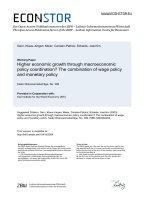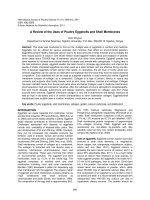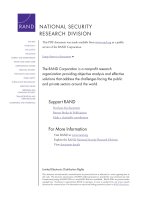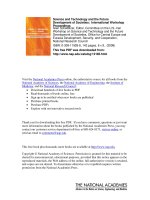The Human Race to the Future: What Could Happen - and What to Do
Bạn đang xem bản rút gọn của tài liệu. Xem và tải ngay bản đầy đủ của tài liệu tại đây (2.75 MB, 1,507 trang )
Praise for…
The Human Race to the Future
“The 21st Century will almost
certainly see more technological
change than any century before. The
computer scientist Daniel Berleant
offers a concise, readable guide to
what might come next, filled with
specific recommendations on what
we all need to do to prepare.”
—Gary Marcus, PhD, New York
University; best-selling author of
Guitar Zero; author of articles in
Wired, Science, Nature, and other
major popular periodicals and
scholarly journals
“I read through much of the book
while teaching for the International
Space University in Australia. It is
… a thought-provoking enterprise
of the first order.”
—Joseph N. Pelton, PhD, Director
of the Space and Advanced
Communications Research Institute
(SACRI) at George Washington
University; founder and Vice
Chairman, Arthur C. Clarke
Foundation; Pulitzer Prize nominee
“Berleant takes the reader on an
elegantly written, thought provoking
ride that could inspire high school
students to be more creative, their
parents and grandparents to be more
future aware, and leaders of nations
around the world to take heed and
act.”
—Donald Maclean, MBChB,
retired family physician,
psychiatrist, and founding
department chair at the University
of Illinois
_____________________
A clear alternative to Wesch’s “The
end of wonder in the age of
whatever”… the reader will share
the excitement and joy of this
integration of futurism and popular
science. According to the author,
“My goal is a view of the future at a
range of topics and time scales,
based on a foundation of science. In
melding futurism and popular
science, I have worked to illuminate
the significance and the beauty of
that synergy.”
_____________________
“The Human Race to the Future is
a wonderful, comprehensive and
timely contribution to the MUST
READ literature on existential
risk.”
—Roman V. Yampolskiy, Director,
Cybersecurity Laboratory,
University of Louisville; author of
six books
“As a technology futurist I am
extremely interested in the topics of
this book. Thank you so much for
writing this excellent book!!”
—Elina Hiltunen, PhD, CEO and
founder of What’s Next Consulting
Oy (Finland); author of book Travel
Guide to the Future (Matkaopas
tulevaisuuteen)
“Daniel Berleant whizzes past the
future and then loops back to look it
in the eye. This is a … brilliant
book.”
—Sabiha Rumani Malik, President
of Sanghata Global; winner of the
2013 Ashoka U-Cordes Award for
Impact, Innovation and Potential for
Replicability
“I have been pleasantly surprised at
the quality and depth of the material
in this book.”
—Luke Hutchison, PhD (MIT),
Google; TED fellow; Singularity
University alumnus
_____________________
“Although many foresight and
futurism books belong in the science
fiction section, Berleant grounds his
writing in scientific facts and
knowledge, while maintaining the
excitement the material deserves.
… the book can expand your view
of the possible.”
—33
rd
Square
(www.33rdsquare.com)
The Human Race
to the Future
What Could Happen —
and What to Do
Daniel Berleant
A Lifeboat Foundation Book
Published by the Lifeboat
Foundation
lifeboat.com
Copyright © 2013 by Daniel
Berleant
All rights reserved. For
permissions contact the publisher or
author.
Translator and international
distributor inquiries welcome.
—
Spiral clock cover design:
Catherine Asaro
Clock art: Francesco De Comité ©
2007
(see his site at
www.lifl.fr/~decomite)
Circuit board clock and highway
covers: Jason Batt
Alien landscape cover: Frank D.
Smith
—
First edition, May 2013
Manufactured in the United States of
America
17 19 21 23 25 24 22 20 18 16
Library of Congress Motivated
Cataloging Data:
Berleant, Daniel.
The human race to the future : what
could happen — and what to do /
Daniel Berleant. — 1st ed.
p. cm.
1. Science—forecasting. 2.
Technology foresight.
3. Science and technology—social
aspects. I. Title.
Includes bibliographic references
and index
QA175.5.B394 2013
This book reflects the views of the
author and does not necessarily
represent the positions of the
Lifeboat Foundation.
Publisher’s page:
lifeboat.com/ex/book
Facebook group:
facebook.com/groups/thehumanracetothefuture
To Joy and Our Next Generation
Table of Contents
Foreword (3 Pages)
Comments by Gil Alterovitz and
Brandon H. Lee
Introduction (7 Pages)
Why Read This Book?
Who doesn’t have at least some
curiosity about the future… what
things will be like one day? This
book gives some answers, spanning
from the current century nearly to
eternity itself. This book is for you
if you are interested in the future,
intrigued by science and technology,
or both.
The First Generation:
The Next Hundred Years
Chapter One (4 Pages)
What it Means That an Hour’s
Work Yields a Week’s Food
Labor productivity is so high we
could all live comfortably working
much less than we currently do.
What does this mean? Will we
work fewer hours in the future than
we do now?
Chapter Two (5 Pages)
Live Anywhere, Work Anywhere
Else
Current commuting and living
practices continue in part because
we’re used to doing it that way.
These habits are ripe for change.
The economic incentives
favor telecommuting and robotic
telepresence. Here is what the
insistent push of these incentives
means for the future of living,
working, and commuting.
Chapter Three (6 Pages)
Keyboards Yesterday, Mind
Reading Tomorrow
Keyboards are the classic way to
interact with computers. However,
general use computers that interact
directly with the electrical activity
of the brain are getting closer with
each passing year.
Chapter Four (6 Pages)
Wiki-Wiki-Wikipedia
Wiki-wikipedia, an extension to
Wikipedia, could provide a view of
any article from the “colored lens”
of any other article automatically.
Yet the short passage concept
demonstrated a hundred years ago
by Paul Otlet’s Mundaneum could
extend Wikipedia even further, from
Wiki-wikipedia to Wiki-wiki-
wikipedia.
Chapter Five (7 Pages)
Smart Pills’n Such: Cognitive
Enhancement the Easy Way
The ancient Greeks used honey
water (which they called hydromel)
to enhance mental performance.
Modern society presents other
possibilities, from pharmaceuticals
to deep brain stimulation. The future
will provide more. Caveat emptor.
Chapter Six (14 Pages)
From Highly Centralized to
Highly Decentralized Society
Modern civilization depends on
centralized food and energy
production, and the resultant
required distribution networks. This
is risky, even dangerous. In the
future, gardening and farming robots
could mitigate the risks of the food
distribution system, and solar
energy could mitigate the risks of
centralized electric utilities. Society
will be much more resilient to
disaster as a result.









